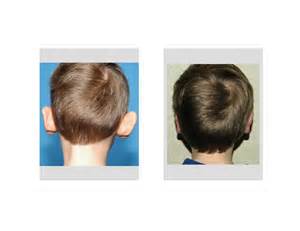The most common congenital ear deformity treated is that of protruding ears. It is very successfully treated by an ear reshaping surgery known as otoplasty. Often referred to an pinning the ears back, it is a procedure that has been around for over 100 years. While originally described as the simple removal of skin on the back of the ear to fold it back, the real success of the procedure is based on the folding of the cartilage and the holding of its new shape with sutures.
While highly successful, one of the common complications of an otoplasty is suture extrusion. This occurs because the knots of the sutures used to fold the cartilage are right under the incisional closure on the back of the ear. Since most plastic surgeons use a permanent suture for long-term retention, the knot has a lifetime to work its way through the skin. Thus, suture extrusion can occur months to years after the surgery. While not usually causing a major problem, it can cause both irritation or even local infection.
In the January 2014 issue of Aesthetic Plastic Surgery, an article was published entitled ‘New Otoplasty Approach: ‘A Laterally Based Postauricular Dermal Flap as an Addition to Mustarde and Furnas to Prevent Suture Extrusion and Recurrence’. In this paper a technique to prevent suture extrusion is described using a dermal flap to cover the cartilage sutures and their knots when the skin is closed on the back of the ear. Rather than just cutting out a traditional ellipse of skin on the back of the ear, the anterior skin flap is de-epithelialized and preserved. It is then used to cover the sutures as it is sewn down to the postauricular fascia or the underside of the medial skin flap. This otoplasty technique modification was in 17 consecutive otoplasty patients. After a follow-up period of 6 to 36 months (mean follow-up of 16 months), the patients were evaluated for ear shape recurrence and/or suture line problems. None were observed which substantiates their conclusion that the posterior auricular dermal flap both prevents suture extrusion and decreases recurrent ear shape deformities.

Dr. Barry Eppley
Indianapolis, Indiana


